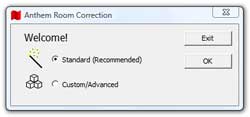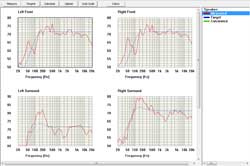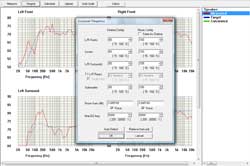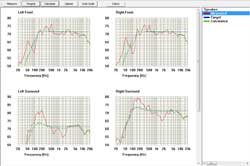Introduction
ARC, or Anthem Room Correction, has been a long time in coming. Its origins can be traced back as far as 1990 to research conducted at Canada’s NRC (National Research Council). Under the supervision of Floyd Toole, the NRC had previously performed landmark research into loudspeaker performance. Statistical analysis of controlled listening tests showed that there was a common thread among speakers which subjectively “sound goodâ€: in an anechoic chamber they were the ones which measured a neutral response, free of coloration. This research literally launched companies like Paradigm who, rather than vaguely poking at speaker design, now had a solid definition of what exactly made a good speaker “good”.
On the heels of that research came the “Athena†project in 1990. Whereas the previous research looked at many different speakers, Athena looked at only a handful of speakers in many, many different rooms Here again, a common thread was found between what statistics showed to be good sounding rooms. I’ll jump ahead just a bit and tell you that it is not what you’d think.
Armed with these data, the next step would be to create a system which could shape the speakers’ response to get the system sounding more like the preferred rooms. It was only a matter of time, over 10 years actually, until DSP power in audio processors was up to the challenge, and a filtering system capable of the incredibly complex task could be put into play.
Specifications
- Product Type: Software Upgrade
- Microphone, Cable, and Stand Included
- ARC Software CD
- RS-232 Serial Cable
- Upgrade/Add-on for Existing D1 and D2 Owners: $399 USA
- New D2 price including ARC, $7,499 USA
- Anthem
What’s in a name?
The term Room Correction, though ubiquitously used in this context, is unfortunately not the industry’s best choice. Room Compensation would be far more accurate. A small distinction of semantics, but a necessary one.
Going back about a decade, several early automated EQ/filter systems were billed as “speaker correctionâ€, which is not a bad way of describing it, since you are in fact changing the signal to the speaker and consequently what comes out of it. The trouble with that name was that it made the feature quite unpopular among audiophiles: no one likes to think there is something “wrong†with their speakers, which needs to be corrected.
Since that time, there has been a growing cognizance among consumers, especially the more serious enthusiasts, with regards to acoustics. It is now undisputed that “the room†has far more influence on system performance than any piece of the system’s electronics. It is my own adage that if forced to make a hypothetical choice, I would always rather have a modest hardware setup in a room with good acoustics than have state of the art hardware in a poor room. But addressing acoustics ranges from the inconvenient, to the expensive, to the downright impossible.
It is small wonder, then, that these new automated filter/EQ systems have now consistently, though in my opinion decievingly, been billed as “room correction†by just about everyone. Unfortunately, marketing departments have pushed forth the notion that by simple application of a filter, the room somehow magically disappears and you are transported to the likes of Dolby or Lucasfilm’s own state of the art mixing facilities.
Simply stated: that is not happening.
Without thinking too much about the issues involved, it would seem plausible that if you take a measurement of the system’s frequency response in the room, and then apply a filter as an inverse of that response, everything would null out and audio nirvana would result.
There are two problems with this sentiment. The first is that it only works that way for one person and one person only, with their head in a vice at that, since the effects of the room change according to your position in it. The second is that the room does not disappear. You might change the sound coming from the speakers, but that sound is still bouncing around. You can’t stop late arrivals and decaying reverb with electronics. Acoustical treatment is the only way to actually alter acoustics.
Room Correction is not a substitute for addressing acoustics (nor is any other automated EQ/Fiter systems, regardless of how they are marketed). However, as you will see in the coming paragraphs, ARC ultimately is an equally important part of the system performance equation, on par with room acoustics. It is a unique must-have component, whether your room is acoustically poor or excellent.
Â
Â
ARC
ARC is the most recent addition to Anthem’s famed D2 Audio/Video Processor Preamp, or Surround Sound Processor , i.e., SSP (existing D1 or D2 owners can purchase it as an add-on kit).
The system consists of three elements: A calibrated USB microphone (complete with robust mic stand), the ARC computer software application, and supporting firmware for the D2 itself. Unlike most such systems on the market, ARC requires a personal computer to set it all up due to the complexity of the system. Just how sophisticated it is will be apparent in a minute.
The software comes with a license file which will only work with a single D2 and microphone serial number combination.
Installation of the Windows application is straightforward (and works just fine under Windows Vista by the way). The supplied microphone connects to the PC via its long USB cable, while the PC connects to the D2 via an RS-232 serial cable (if your PC does not have a serial port, you will need your own USB-to-RS232 converter). On launch, the software presents you with a choice of Standard or Advanced operation.
The Standard option is like a setup wizard. You start by telling the system which channels you have (i.e., what your speaker configuration is).  You can if you wish have completely different setups for Movies and Music. I am personally diametrically opposed to the notion that the two source materials need different settings. The performance metrics of Hi-Fi audio reproduction do not change with media. Hi-Fi is Hi-Fi, period. The feature does have a couple very good inadvertent uses through: you can define a much narrower listening area for one mode compared to the other such that you can have one mode optimized for a theater full of people, and the other optimized for when you are the sole critical listener. In addition, having two different setups makes comparing different ARC settings a breeze. By setting different “targets†(which we’ll explain in moment) for Movie and Music, one can very easily A/B the different settings later by flipping between the Movie/Music presets in the D2.
You must also tell the system how many seats you have (or really how many locations in the room to measure). ARC requires you give it a minimum of five positions to measure.  Even if you have just, say, two chairs, you must take measurements at at least five positions, and they must be at least 12 inches from each other (preferably 20). Although at first it may seem pointless to measure what the sound is like in places no listener will be, this minimum is imposed so that the system doesn’t misinterpret what it is hearing in the actual seats in terms of identifying what is a room mode and what isn’t (in other words, one or two measurement positions just don’t tell you the whole story of the room).
If you chose the Standard option, that’s the end of your input. The system will ask you to get the mic ready in the first central, or prime, seat, the PC will then take control of the D2, ordering it to cycle power, and start the first set of test noise bursts through each speaker. You’ll be prompted to move the mic to the second position, it will repeat the test noise bursts, prompt you to move the mic to the third seat, and so on. The software then crunches the numbers, figures out basic setup parameters such as speaker level and distance, sets crossover points, and ultimately figures out what filter it is going to apply to each speaker. Its last step is to send all these data to the D2, and you are done. You can go into source setup and make sure it indicates that EQ is on.
The Advanced mode is much more interesting.
You start the same way, but on completion of the measurements, the application shows you a frequency response graph for each speaker. These graphs are a simplification in that they represent an average of all the measurements taken for each speaker, yet the system is using the separate measurements from all positions to calculate the requisite target curves and filters.
Â
Â
It’s all about hitting the target.
When we refer to the target, we are talking about what we want the sound to be, never mind for a minute how we actually do it. Counter-intuitively, ARC does not attempt a perfectly flat speaker response for several very good reasons. The first is that it is impossible to get a perfectly flat, or even uniform, response for every listener in a room, so there is no point in trying. The best systems, like ARC, aim for a “best overall†fit. Thats not new, as other systems, such as Audyssey, do the same. What is unique is the fact that Paradigm/Anthem, through their many years of user listening experience and leveraging the Athena project we mentioned earlier, really know what constitutes “good soundâ€.
Some stuff matters, some stuff doesn’t in terms of psyhcoacoustics. What ARC brings to the table is unique: its particular set of audio and room characteristics which their research has shown to be the most significant and “worth” fixing, as well as that what is not and is best left undone. One of the more tangible aspects of this is the concept of room gain, and is one of the target settings you have control over.
Room gain is basically the amplitude boost any audio source (be it a speaker or even your own voice) gets in the upper mid-bass range from the boundaries of the room. Filter, or correct for, this natural boost, and you end up with a very unpleasant, dull sound because our ear-brain just “expects†room gain. ARC assumes you are not using poor speakers, and thus when it sees a common “swell†in the frequency response of the measurements, considers that to be room-gain and, here is the key, does not target it for correction the way it does a room mode. In other words, if you look at the target curve in the graphs, it has a very shallow hump (in my case about 4 dB) in the upper bass, and yes, we want that.
But isn’t that distortion? Yes and no. First, it is by any stretch very mild in amplitude as compared to other aberrations in the system’s response, yet correcting it is in a very real way worse than keeping it. I was challenged by Anthem to “just try it†by accepting all the recommended target settings for Movie mode, and zeroing out the room-gain for Music mode. Indeed, correcting room gain makes it sound very dead, literally.
Another parameter you can play with in the target settings is maximum frequency to bother filtering or correcting at all. Anthem elects 5 kHz as a default here. It’s not that their filters can’t keep up, but it gets so complicated and messy up there that there is virtually nothing you can do electronically (unless you have really bad speakers, which ARC assumes you dont’).
Here is a prime example of how/why acoustical treatments will always be equally important along side ARC: nothing controls and focuses treble like some absorptive panels strategically placed at first reflection points.
Also part of the target settings is the crossover frequency for each speaker. This is one that is really going to ruffle some feathers as, with little exception, ARC will tend to use higher frequencies than people would expect, sometimes much higher.  It’s not uncommon for ARC to select upwards of 160 Hz for what some people consider full-range speakers. It’s also not uncommon for it to pair that with a subwoofer low-pass of 80-100 Hz. In other words, ARC will in many cases intentionally create a “hole†in the system’s electrical response, because through a combination of the filtering and the room itself, the difference ultimately is taken into consideration (plus you get a nice headroom bonus as compared to crossing everything over at, say, 80 Hz). People with big tower speakers are not going to like learning that the best fit for them in the room with ARC’s help means high-passing them at something close to 100 Hz, but they are going to have to get over it. What comes first: your pride, or getting the best sound possible?
You can, of course, override these crossover frequency choices at this point, and although Anthem is confident with what the system chooses, depending on your particular speakers and moreover the position of your subwoofer, you may want to force a lower crossover. In my case for example ARC elected upwards of 160 Hz crossover for my front channels, which yielded excellent results but ended up leaving me with a subwoofer which simply drew too much attention to itself. Forcing everything to THX-80 Hz still “worked”, though I may have sacrified a little of what ARC is capable of by doing so. Regardless of why you want to change the crossover settings, if in fact if you do, you must do it here within the ARC PC software, as the calculation of the final filters are done here and takes the crossover frequencies into account. If you change the crossover frequencies in the D2 after the fact, ARC will be thrown completely out of whack.
Once you are satisfied with the target settings, the next step is for ARC to calculate the actual filters it will apply. This is heady stuff.
ARC uses minimum phase IIR (Infinite Impulse Response) filters instead of the more common FIR filters, since these last, especially at low frequencies, incur long delays which are complex to account for.
For those who love numbers: from the microphone’s 16 bit integer data, signal processing calculations on the PC are done with 64 bit floating point values, yielding 24 bit fixed point coefficients downloaded to the D2. The IIR filters in D2 have 56 bit fixed point accumulation and use 1st order error feedback when converting to 24 bit fixed point.
The net result of all the number crunching is a green “calculated†curve which gets added to the graphs. These are what the response would be if a hypothetical “post†measurement were taken.  This curve is very revealing in that it does NOT look like a ruler-flat response.
“Anechoic chambers sound like crapâ€.  I don’t know who first said it, but we all repeat it now because they are words to live by. Seeking a ruler flat response with no “sound†from the room is not what we want. Graphs of Impulse Response measurements are really misleading in this respect in that they make things look a LOT worse than they really are. Again, this goes back to knowing what matters and what doesn’t.
Take a look at the ones I’m showing you here.  You would think my room and/or speakers are garbage, but I assure you neither is the case. Thats not to say there aren’t some major issues to correct, sometimes more, sometimes less depending on the room, but it’s not as though rooms are as bad as an Impulse Response measurement graph looks, or more to the point that we would want it to look ruler flat.
The point is, what you do see in the visuals is an overall correction of the most egregious distortions. But no visual aid or graph is going to convey to you what ARC does to you system . . . trust me, you have to hear it to believe it. I’ll explain in a minute.
Â
Â
Usage
Before we talk about the “how it soundsâ€, a few notes on the package.
One way in which I was really disappointed is the mic stand. Anthem saw fit to include a real quality piece: solid telescoping shaft and a cast iron base with their logo. There’s just one problem: It’s too tall! When set to its shortest stature, and placed in one of your seats, the mic will be at least six inches higher than where most people’s head would be. I ended up having to extend it as far as it would go, set it on the floor in front of the seat, and tilt it back until the mic ended up where it should be. And yes, that makes a difference. I did a set of measurements with the mic at the “wrong” height, and another with it at the “correct” height, and the graphs were notably different.
While anyone who owns a D2 almost certainly has a PC (or two or three), unless one of them happens to be a Media Center sitting next to the D2, playing with ARC is a real hassle, at least for me it was (lugging the PC down to the theater multiple times). Just something to be aware of.
Anthem has on their hands the makings of a very sweet piece of software in ARC, and I hope they don’t leave it as is. Even though it’s not billed as such, you have a very powerful, accurate sound measuring tool on your hands. In the future, it would be nice for example if we could take measurements of individual speakers (as opposed to going through the whole ARC setup process), so that small changes in a speaker’s placement could be hashed out.
In Practice
I’ve listened to some other room correction systems, and at best, the improvements have been subtle.
ARC on the other hand, I am prepared to admit, made a profound difference in my setup, and in ways I did not expect or even dreamed needed help. Simply stated, with the exception of doing actual acoustical treatments, engaging ARC is like nothing else I have experienced in terms of altering, for the better, a system’s sound.
To put this last statement into perspective, I am of the opinion that changes in audio hardware manifest differences in sound which are best described as ranging from subtly perceivable (such as different speakers) to being so slight as to question whether there even is a difference at all (cables anyone?) So when I say something makes a profound difference, I’m not mincing words.
The bass now met expectations in that by principally correcting the nasty 52 Hz room mode I knew I had, the low end is now much tighter and more precise tonally. That’s not so amazing, as I’ve been able to do pretty close to that myself with a few bands of parametric EQ. It is the midrange, the vocal range in particular, which floored me.
I have what I know for a fact to be excellent, responsible speakers both in the frequency and transient response domains. My room, while not perfect, has at least a modicum of acoustical treatments, leaving me with (relatively) decent overall sound.
Flipping ARC On/Off is a humbling experience.
I don’t quite know how to describe the improvements to the system’s sound without myself coming off as disingenuous. I’m the first one to point a finger at marketing departments for making incredulous claims. Yet here the only way I can in typed word describe to you the difference is to say it is the difference between muffled and clear sound. Seriously. No joke. I’m not embellishing. If you don’t believe me, find someone with a D2 equipped with ARC and listen for yourself.
Let me say that again.  ARC “On”: clear, articulate sound. ARC “Off”: someone draped a blanket over the speakers. How can this be? I didn’t think my system sounded that bad before the D2 with ARC arrived for review, and now I know that it did by comparison.
The explanation is actually simple: ARC (and other such systems) are unique in that by definition they let us do very proper A/B’ing, something which brings into very sharp focus the actual manifestation of a change. Our auditory/acoustic memories are short, very short, and anyone who claims they have “expert†ears and are more skilled than others at this stuff may be delusional.
That goes back to Floyd Toole/NRC research.  It appears that 99% of audiophiles will never be able to A/B anything properly for simple lack of the requisite tools. The time it takes to, say, replace a speaker is usually too long. In order to properly A/B two loudspeakers they must be run through a very special switch which compensates for different efficiencies and impedance in order for a flip to be both fast enough as well as “fair†(I’ve had one such an opportunity, and I will say that ARC is at least as significant as changing speakers, and in fact I think more so). A/B’ing ARC on the other hand requires nothing more than the D2 remote in your hand, so the experience is somewhat stacked in its favor. The bottom line though is that if you want the best sound, you’ll want something like ARC, period.
By definition, what exactly ARC does is going to be different for every single system it is implemented in, yet my reactions and observations I’m told have a curious common thread with virtually all feedback that Anthem has received to date, in particular with regards to the tonality of the bass and the surprise clarity in the vocal range. In other words, all rooms share some commonality which ARC is addressing, even though the actual acoustical signatures may be radically different.  It seems that all that research at NRC really has born fruit because Anthem is not just compensating for the room.  ARC is actually doing one better than that by hitting their unique “good sound” target.
Conclusions
ARC is a very scary product. If you are one of those who insists on having the best sound, and you experience ARC, especially if you can do so with your existing system, one of two things will happen: Either you will buy a D2 with ARC, or you will stop listening to your existing system knowing just how much better it would be with ARC.
Think I’m waxing peotic? Think again. I dare you!








